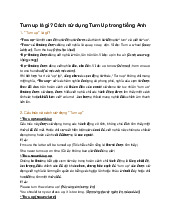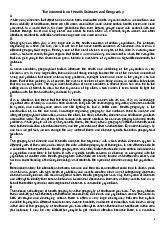






Preview text:
If by "suburb" is meant an urban margin that grows more rapidly than its already
developed interior, the process of suburbanization began during the emergence of the
industrial city in the second quarter of the nineteenth century. Before that period the city
was a small highly compact cluster in which people moved about on foot and goods were
conveyed by horse and cart. But the early factories built in the 1830's and 1840's were
located along waterways and near railheads at the edges of cities, and housing was
needed for the thousands of people drawn by the prospect of employment. In time, the
factories were surrounded by proliferating mill towns of apartments and row houses that
abutted the older, main cities. As a defense against this encroachment and to enlarge
their tax bases, the cities appropriated their industrial neighbors. In 1854, for example,
the city of Philadelphia annexed most of Philadelphia County. Similar municipal
maneuvers took place in Chicago and in New York Indeed, most great cities of the
United States achieved such status only by incorporating the communities along their borders.
With the acceleration of industrial growth came acute urban crowding and
accompanying social stress conditions that began to approach disastrous proportions
when, in 1888, the first commercially successful electric traction line was developed.
Within a few years the horse - drawn trolleys were retired and electric streetcar networks
crisscrossed and connected every major urban area, fostering a wave of suburbanization
that transformed the compact industrial city into a dispersed metropolis. This first phase
of mass - scale suburbanization was reinforced by the simultaneous emergence of the
urban Middle class whose desires for homeownership In neighborhoods far from the
aging inner city were satisfied by the developers of single-family housing tracts.
1. Which of the following is the best title for the passage?
(A) The growth of Philadelphia
(B) The Origin of the Suburb
(C) The Development of City Transportation
(D) The Rise of the Urban Middle Class
2. The author mentions that areas bordering the cities have grown during periods of (A) industrialization (B) inflation (C) revitalization (D) unionization
3. In line 10 the word "encroachment" refers to which of the following? (A) The smell of the factories
(B) The growth of mill towns
(C) The development of waterways (D) The loss of jobs
4. Which of the following was NOT mentioned in the passage as a factor in nineteenth-century suburbanization? (A) Cheaper housing (B) Urban crowding
(C) The advent of an urban middle class
(D) The invention of the electric streetcar
5. It can be inferred from the passage that after 1890 most people traveled around cities by (A) automobile (B) cart (C) horse-draw trolley (D) electric streetcar
6. Where in the passage does the author describe the cities as they were prior to suburbanization. (A) Lines 3-5 (B) Lines 5-9 (C) Lines 12- 13 (D) Lines 15-18 BABADA Passage 5
The first English attempts to colonize North America were controlled by individuals
rather than companies. Sir Humphrey Gilbert was the first Englishman to send colonists
to the New World. His initial expedition, which sailed in 1578 with a patent granted by
Queen Elizabeth was defeated by the Spanish. A second attempt ended in disaster in 1583, when Gilbert and his
ship were lost in a storm. In the following year, Gilbert's half brother, Sir Water Raleigh,
having obtained a renewal of the patent, sponsored an expedition that explored the coast
of the region that he named "Virginia." Under Raleigh's direction efforts were then made
to establish a colony on Roanoke island in 1585 an6 1587. The survivors of the first
settlement on Roanoke returned to England in 1586, but the second group of colonists
disappeared without leaving a trace. The failure of the Gilbert and Raleigh ventures
made it clear that the tasks they had undertaken were too big for any one colonizer.
Within a short time the trading company had supplanted the individual promoter of colonization.
1. Which of the following would be the most appropriate title for the passage?
(A) The Regulation of Trading Companies
(B) British - Spanish Rivalry in the New World
(C) Early Attempts at Colonizing North America
(D) Royal Patents Issued in the 16th Century
2. The passage states which of the following about the first English people to be involved in
establishing colonies in North America?
(A) They were requested to do so by Queen Elizabeth.
(B) They were members of large trading companies.
(C) They were immediately successful.
(D) They were acting on their own.
3. According to the passage, which of the following statements about Sir Humphrey Gilbert is true?
(A) He never settled in North America.
(B) His trading company was given a patent by the queen.
(C) He fought the Spanish twice. (D) He died in 1587.
4. When did Sir Walter Raleigh's initial expedition set out for North America? (A) 1577 (B) 1579 (C) 1582 (D) 1584
5. Which of the following can be inferred from the passage about members of the first Roanoke settlement?
(A) They explored the entire coastal region.
(B) Some did not survive.
(C) They named the area "Virginia".
(D) Most were not experienced sailors.
6. According to the passage, the first English settlement on Roanoke Island was established in (A) 1578 (B) 1583 (C) 1585 (D) 1587
7. According to the passage, which of; the following statements about the second settlement on Roanoke Island is true?
(A) Its settlers all gave up and returned to England.
(B) It lasted for several years.
(C) The fate of its inhabitants is unknown.
(D) It was conquered by the Spanish. CDADBCC
Insects' lives are very short and they have many enemies, but they must survive
long enough to breed and perpetuate their kind. The less insect-like they look, the better
their chance of survival. To look "inedible" by resembling or imitating plants is a
deception widely practiced by insects. Mammals rarely use this type of camouflage, but
many fish and invertebrates do.
The stick caterpillar is well named. It is hardly distinguishable from a brown or
green twig. This caterpillar is quite common and can be found almost anywhere in North
America. It is also called "measuring worm" or "inchworm." It walks by arching its body,
than stretching out and grasping the branch with its front feet then looping its body again
to bring the hind feet forward. When danger threatens, the stick caterpillar stretches its
body away from the branch at an angle and remains rigid and still, like a twig, until the danger has passed.
Walking sticks, or stick insects, do not have to assume a rigid, twig-like pose to
find protection; they look like inedible twigs in any position. There are many kinds of
walking sticks, ranging in size form the few inches of the North American variety to some
tropical species that may be over a foot long. When at rest their front legs are stretched
out. heightening their camouflage. Some of the tropical species are adorned with spines
or ridges. imitating the thorny bushes or trees in which they live.
Leaves also seem to be a favorite object for insects to imitate. Many butterflies can
suddenly disappear from view by folding their wings and sitting quietly among the foliage that they resemble.
1. What is the main subject of the passage?
(A) Caterpillars that live in trees
(B) The feeding habits of insects
(C) How some insects camouflage themselves
(D) Insects that are threatened with extinction
2. In lines I and 4, the word "enemies" refers to
(A) other creatures competing for space (B) extreme weather conditions
(C) creatures that eat insects (D) inedible insects
3. According to the passage, how does the stick caterpillar make itself look like a twig?
(A) By holding its body stiff and motionless
(B) By looping itself around a stick
(C) By changing the color of its skin
(D) By laying its body flat against a branch
4. Which of the following is true of stick insects?
(A) They resemble their surroundings all the time.
(B) They make themselves look like other insects.
(C) They are camouflaged only when walking.
(D) They change color to make themselves in visible.
5. Which of the following are NOT mentioned in the passage as objects that are imitated as a means of protection? (A) Thorns (B) Flowers (C) Leaves (D) Sticks
6. In which paragraph does the author describe the way in which stick caterpillars move? (A) Paragraph one (B) Paragraph two (C) Paragraph three (D) Paragraph four
7. Where in the passage does the author describe the habitat of tropical stick insects? (A) Line 7 (B) Lines 10-11 (C) Lines 13-15 (D) Lines 16-17 CCAABBC
Botany, the study of plants, occupies a peculiar position in the history of human
knowledge. For many thousands of years it was the one field of awareness about which
humans had anything more than the vaguest of insights. It is impossible to know today
just what our Stone Age ancestors knew about plants, but from what we can observe of
pre-industrial societies that still exist, a detailed learning of plants and their properties
must be extremely ancient. This is logical. Plants are the basis of the food pyramid for all
living things, even for other plants. They have always been enormously important to the
welfare of peoples, not only for food, but also for clothing, weapons, tools, dyes:
medicines, shelter, and a great many other purposes. Tribes living today in the jungles of
the Amazon recognize literally hundreds of plants and know many properties of each. To
them botany, as such, has no name and is probably not even recognized as a special branch of "Knowledge at all.
Unfortunately, the more industrialized we become the farther away we move from
direct contact with plants, and the less distinct our knowledge of botany grows. Yet
everyone comes unconsciously on an amazing amount of botanical knowledge, and few
people will fail to recognize a rose, an apple, or an orchid. When our Neolithic ancestors,
living in the Middle East about 10,000 years ago, discovered that certain grasses could
be harvested and their seeds planted for richer yields the next season, the first great step
in a new association of plants and humans was taken. Grains were discovered and from
them flowed the marvel of agriculture: cultivated crops. From then on, humans would
increasingly take their living from the controlled production of a few plants, rather than
getting a little here and a little there from many varieties that grew wild – and the
accumulated knowledge' of tens of thousands of years of experience and intimacy with
plants in the wild would begin to fade away.
1. Which of the following assumptions about early humans is expressed in the passage?
(A) They probably had extensive knowledge of plants.
(B) They thought there was no need to cultivate crops.
(C) They did not enjoy the study of botany.
(D) They placed great importance on the ownership of property.
2. What does the comment "This is logical" in line 6 mean?
(A) There is no clear way to determine the extent of our ancestor’s knowledge of plants.
(B) It is not surprising that early humans had a detailed knowledge of plants.
(C) It is reasonable to assume that our ancestors behaved very much like people in preindustrial societies.
(D) Human knowledge of plants is well organized and very detailed.
3. According to the passage, why has general knowledge of botany begun to fade?
(A) People no longer value plants as a useful resource.
(B) Botany is not recognized as a special branch of science.
(C) Research is unable to keep up with the increasing numbers of plants.
(D) Direct contact with a variety of plants has decreased.
4. In line 16, what is the author’s purpose in mentioning "a rose, an apple, or an orchid"?
(A) To make the passage more poetic
(B) To cite examples of plants that are attractive
(C) To give botanical examples that all readers will recognize
(D) To illustrate the diversity of botanical life
5. According to the passage, what was the first great step toward the practice of agriculture?
(A) The invention of agricultural implements and machinery
(B) The development of a system of names for plants
(C) The discovery of grasses that could be harvested and replanted
(D) The changing diets of early humans
6. The relationship between botany and agriculture is similar to the relationship between zoology (the study of animals) and (A) deer hunting (B) bird watching (C) sheep raising (D) horseback riding
7. In which lines in the passage does the author describe the beneficial properties that plants have for humans? (A) Lines 1-2 (B) Lines 7-9 (C) Lines 11-12 (D) Lines 14-16 ABDCCCB
The agricultural revolution in the nineteenth century involved two things: the
invention of labor-saving machinery and. the development of scientific agriculture. Labor
- saying machinery, naturally appeared, first where labor was 8carce. "In Europe," said,
Thomas Jefferson, the object is to make the most of: their land, labor being abundant;.
here it, is to make the most of our labor, land being abundant. It was in America,
therefore, that the great advances in nineteenth - century agricultural machinery first came.
At the opening of the century, with the exception of a crude plow farmers could
have carried practically all of the existing agricultural implement on their backs; by 1860,
most of the machinery in use today had been designed in an early form. The most
important of the early inventions was the iron plow. As early as 1790 Charies Newbold of
New Jersey had been working on the of a cast – iron plow and spent his entire fortune
in introducing his invention. The farmers, however, would have none of it, claiming that
the iron poisoned the soil and made the weeds grow. Nevertheless, many people
devoted their attention to the plow, until in 1869 James Oliver of South Bend, Indiana,
turned out the first chilled-steel plow.
1. What is the main topic of the passage?
(A) The need for agricultural advances to help feed a growing population
(B) The development of safer machines demanded by the labor movement
(C) Machinery that contributed to the agricultural revolution
(D) New Jersey as a leader in the agricultural revolution
2. The word "naturally" as used in line 3 is closest in meaning to which of the following? (A) Gradually (B) Unsurprisingly (C) Apparently (D) Safely
3. The expression "make the most of" in line 4 is closest in meaning to which of the following?
(A) Get the best yield from (B) Raise the price of (C) Exaggerate the worth of (D) Earn a living on
4. Which of the following can be inferred from what Thomas Jefferson said?
(A) Europe was changing more quickly than America.
(B) Europe had greater need of farm machinery than America did.
(C) America was finally running out of good farmland.
(D) There was a shortage of workers on American farms.
5. It can be inferred that the word "here' in line 4 refers to (A) Europe (B) America (C) New Jersey (D) Indiana
6. What point is the author making by stating that farmers could carry nearly all their tools On their backs?
(A) Farmers had few tools before the agricultural revolution.
(B) Americans were traditionally self - reliant.
(C) Life on the farm was extremely difficult.
(D) New tools were designed to be portable.
7. Why did farmers reject Newbold's plow?
(A) Their horses were frightened by it.
(B) They preferred lighter tools. (C) It was too expensive.
(D) They thought it would ruin the land. CBADBAD
It was not "the comet of the century experts predicted it might be. Nevertheless,
Kohoutek had provided a bonanza of scientific information. It was first spotted 370 million
miles from Earth, by an astronomer who was searching the sky for asteroids, and after
whom the comet was named. Scientists who tracked Kohoutek the ten months before it
passed the Earth predicted the comet would be a brilliant spectacle. But Kohoutek fell
short of these predictions, disappointing millions of amateur sky watchers, when it proved
too pale to be seen with the unaided eye. Researchers were delighted nonetheless with
the nevi information they were able to glean from their investigation of the comet.
Perhaps the most significant discovery was the identification of two important chemical
compounds-methyl cyanide and hydrogen cyanide-never before seen in comets, but
found in the far reaches of interstellar space. This discovery revealed new clues about
the origin of comets. Most astronomers agree that comets are primordial remnants from
the formation of the solar system, but whether they were born between Jupiter and
Neptune or much farther out toward interstellar space has been the subject of much
debate. If compounds no more complex than ammonia and methane, key components of
Jupiter, were seen in comets, it would suggest that comets form within the planetary
orbits. But more complex compounds such as the methyl cyanide found in Kohoutek,
point to formation far beyond the planets there the deep freeze of space has kept them unchanged.
1. What is the subject of the passage?
(A) What was learned from Kohoutek
(B) What was disappointing about Kohoutek (C) Where Kohoutek was spotted (D) How Kohoutek was tracked
2. Why was Kohoutek referred to as "the comet of the century"?
(A) It was thought to be extremely old.
(B) It passes the Earth once a century.
(C) Scientists predicted it would be very bright.
(D) Scientists have been tracking it for a century.
3. In what respect was Kohoutek a disappointment?
(A) It could be seen only through special equipment.
(B) It did not approach the Earth.
(C) It did not provide valuable scientific information.
(D) It was moving too rapidly for scientists to photograph.
4. Before the investigation of Kohoutek, where had methyl cyanide been known to exist? (A) In comets (B) On asteroids
(C) Between Jupiter and Neptune
(D) Beyond the Earth's solar system
5. According to the passage, what is one major component of Jupiter? (A) Hydrogen cyanide (B) Methyl cyanide (C) Hydrogen (D) Ammonia
6. What aspect of Kohoutek did scientists find most interesting? (A) Its shape (B) Its composition (C) Its orbit (D) Its size
7. Which of the following questions is best answered by information gained from Kohoutek?
(A) Where were comets formed? (B) When were comets formed?
(C) When was the solar system formed?
(D) How was the solar system formed? ACADDBA




